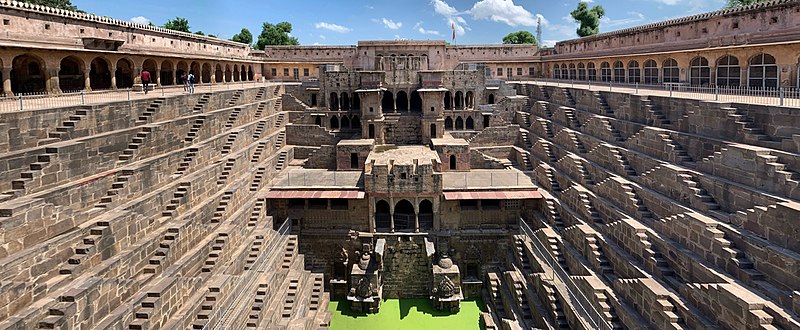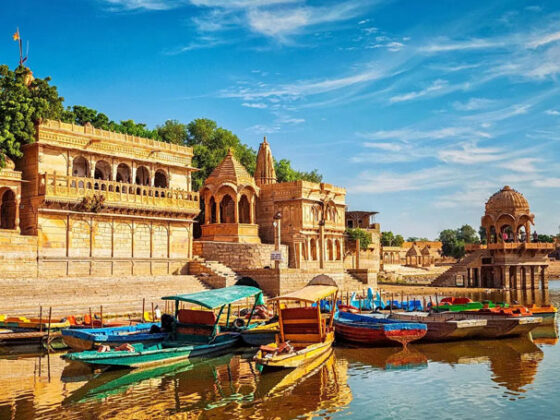Exploring the Hidden Marvel of Rajasthan: A Journey to Lotwara and Chand Baori
Having spent nearly 30 years of my 52-year journey in Gujarat, I have explored the most remote corners of Gujarat and Rajasthan. However, my recent visit to Lotwara, a quaint village just two hours from Jaipur, gifted me with unforgettable memories. One of the highlights was my exploration of Chand Baori, one of India’s most magnificent step-wells. Nestled near Lotwara village along the Agra-Jaipur Highway, the Abhaneri step-well is approximately 105 km from Jaipur. This architectural marvel, built over a thousand years ago in Abhaneri village near Heritage Fort Lotwara, stands as one of the largest and most intricate step-wells in the world.
A Journey Through Time: Discovering Chand Baori
My recent trip to Heritage Fort Lotwara, located near the ninth-century Harsiddhi Mata Temple and Abhaneri step-well, was brief but deeply enriching. At Lotwara, I witnessed architectural brilliance that left an indelible mark on my soul.
Chand Baori, also known as the Abhaneri Stepwell, is an architectural gem surpassing many globally recognized wonders. Hidden from mainstream tourism, this historical marvel provides a tranquil retreat for Indian families seeking solace from modern-day stress. Constructed over a millennium ago by the Pratihara ruler King Chand, this step-well stands as a testament to India’s glorious architectural heritage.
A Glimpse into the Grandeur of Chand Baori
Chand Baori is an engineering masterpiece featuring thousands of symmetrical steps leading down to pristine cobalt blue waters. Built between the 8th and 9th centuries, this grand structure comprises 3,500 narrow steps arranged in a perfect geometric pattern. Step-wells like these played a crucial role in Rajasthan’s arid landscape, ensuring a year-round water supply.
While no longer in use today, Chand Baori continues to attract visitors worldwide with its hypnotic symmetry and unparalleled design. Measuring 64 feet in depth, it is India’s largest and deepest step-well, spanning 13 levels. Named after King Chand of the Gurjara-Pratihara dynasty, descendants of Lord Ram’s brother Laxman, this masterpiece flourished between the 6th and 10th centuries AD. The dynasty’s capital was Mandore, near Jodhpur. Even today, modern architects find it challenging to replicate the intricate geometric precision of Chand Baori.
Rajasthan Darshan: A Transformational Experience
My “Rajasthan Darshan” journey was more than just a travel experience; it was a deep dive into history, culture, and architectural brilliance. Engaging with fellow travelers and ZeNLP workshop participants enriched my understanding of life and learning. ZeNLP’s philosophy promotes continuous self-improvement, and our workshops incorporate folklore, proverbs, and stories gathered from my extensive travel experiences.
The grandeur of Chand Baori remains unparalleled. Nearly all its steps remain intact, showcasing the remarkable engineering and artistic prowess of ancient Indian craftsmen. Despite today’s technological advancements, modern architects would struggle to recreate such a marvel. The western side of the well features a beautifully extended wall, constructed with bricks and reinforced with stone, supported by vertical brackets arranged in multiple tiers. Intricate carvings depicting divine forms of Mataji adorn the structure. Historically, lemongrass surrounded the well, imparting an alkaline quality to the water, making it ideal for bathing.
Heritage Fort Lotwara: A Timeless Retreat
Upon entering Lotwara Fort, visitors are greeted by a majestic wall enclosing this historic heritage hotel, which recently underwent extensive renovations. This winter, travelers can experience luxury in one of its 12 elegantly restored rooms. Towering trees, standing as silent sentinels, house numerous migratory birds whose melodious calls echo at dawn. Inside the fort, peacocks dance gracefully under a 500-year-old Peepal tree, while Plum-Headed Parakeets create a vibrant spectacle at sunset.
Despite Rajasthan’s focus on commercial tourism, attractions like Chand Baori deserve greater recognition. Having explored 35 countries, I can confidently say that the mesmerizing symmetry of Chand Baori rivals architectural wonders spanning 5,000 years of history.
The step-well comprises seven levels of meticulously arranged steps, demonstrating the architectural genius of Rajput kings who built it over a millennium ago without modern technology. Initially designed as simple water reservoirs, step-wells evolved into intricate structures blending functionality with aesthetics. Among all the step-wells in Rajasthan, Abhaneri stands out as the most magnificent.
Where to Stay in Lotwara?
Heritage Fort Lotwara is the only heritage hotel near Abhaneri Stepwell, offering an exclusive retreat for travelers exploring this hidden gem. A deluxe double room costs approximately Rs. 4,500 per night, inclusive of all meals and taxes for two persons. This boutique heritage hotel attracts high-spending Indian and international tourists. Architecture and design students, as well as birdwatchers, will find Lotwara an ideal weekend destination.
The spacious rooms comfortably accommodate a family of four with extra beds. Bathrooms are equipped with hot and cold water showers. The Abhaneri Stepwell tour, including a chauffeur-driven car and a packed vegan lunch, costs Rs. 1,500 per person, inclusive of the entry fee. As there are only 12 double rooms at Heritage Fort Lotwara, advance booking is highly recommended. Contact Lokendra Singh Lotwara, Giriraj Singhji, or Amrendra Singh Lotwara at +91-9929880684 / 9929648512 / 9460765756 for reservations.
Culinary Delights: Where to Eat in Lotwara?
The best dining experience in Lotwara is at Heritage Fort Lotwara, where guests can savor authentic, home-cooked Rajasthani meals. A traditional vegetarian breakfast includes farm-fresh whole wheat parathas with mint chutney and sattu porridge. Several vegetarian dhabas in Lotwara village serve simple yet delicious meals like roti, dal, and aloo ki sabzi.
For vegan travelers, fresh fruits like bananas, watermelons, and musk melons are available at local markets. I highly recommend purchasing seedless dates, walnuts, raisins, and cashews en route to Abhaneri Stepwell and storing them in an airtight metal tiffin for a nutritious snack during the journey.
A traditional Rajasthani lunch features desi whole wheat parathas, dal, dudhi ki sabzi, and rice—a perfectly balanced vegan meal. Along the Agra-Jaipur highway, travelers can find several restaurants serving authentic Rajasthani cuisine. Hot bajra (millet) rotis paired with flavorful garlic-infused dal and cumin-flavored potatoes offer a true taste of Rajasthan.
How to Reach Heritage Fort Lotwara?
The nearest international airport is Indira Gandhi International Airport in New Delhi, while Jaipur Airport serves as the closest domestic airport. Indian tourists can reach Jaipur from New Delhi via multiple travel options. The scenic 105 km drive from Jaipur to Lotwara takes approximately two hours. The nearest railway station is Bandikui, located 20 km away, and Agra Airport is 125 km from Lotwara.
Final Thoughts: A Journey to Remember
Despite its open structure, Chand Baori maintains a natural cooling system, with temperatures at the bottom being 5-6 degrees lower than the surface, even today! Dedicated to Harsiddhi Mata, the Goddess of Joy and Happiness, this step-well holds immense spiritual and historical significance.
During my visit, I was captivated by the 500-year-old trees in Lotwara. Standing beneath these ancient giants and absorbing their cosmic energy was an experience of pure rejuvenation. Rajasthan’s natural and architectural wonders continue to inspire me, and I hope this travel blog encourages you to explore them as well!
For feedback, reach out to zenlp@rediffmail.com. Let’s celebrate India’s rich heritage and uncover its hidden gems together!









